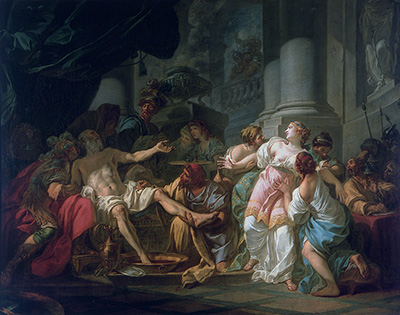Painted in 1773, this painting is beautiful and accomplished. The theme, The Death of Seneca, was most likely given to the artist – along with many of his contemporaries – as a challenge to win the highly coveted Prix de Rome.
This challenge was put out by the Royal Academy, based where the Louvre is sited now, and awarded the winning artist the chance to travel to Rome for three to five years to study art from the ancient masters, absorbing influences and culture and providing confidence and polish to their work. David had already tried out for the prize twice and been turned down. He had almost given up, but the Academy persuaded him to keep trying.
Taking this as assurance of winning the prize this time, he set to work – and lost again. (He did win the prize with his next entry, a depiction of Erasistratus Discovering the Cause of Antiochus' Death, but the three failed attempts marked the beginning of his hate-love-hate affair with the Royal Academy). Seneca (known as Seneca the Younger) was a famous Roman statesmen and writer, leaving detailed and fascinating accounts of life under Claudius, Caligula, and Nero. He was ordered to suicide by Caligula who was affronted by Seneca's oratorial prowess, but Seneca persuaded the mad emperor that he was ill and would die soon anyway.
After a spell in exile, Seneca made his way back into favour and soon became rich and powerful – a little too rich, perhaps – he had a habit of forcing unwanted loans onto unsuspecting victims and then demanding repayment with brutal penalties for defaulting. It is believed that the Iceni uprising in England, under Boudicca, were partly caused by the imposition of these loans. Finally, when he was an elderly man, Seneca was thought to be complicit in a plot to kill Nero, who ordered his immediate suicide. Accordingly, Seneca put his affairs in order and then slit several veins and took poison. Instead of a quick, clean death he took a long painful time to die, which was blamed on his age and poor diet.
It is these moments that David has captured in the oil on canvas painting: Seneca dying slowly, by inches, as his servants, friend and wife watch in an agony of despair. His wife, longing to die with him, is being restrained by three females, probably servants or ladies-maids by their garb, while Seneca is surrounded by men, holding his bleeding limbs and staring into his face, as though beseeching him not to die. A large painting: 123cm by 160cm, the figures are large and the emotion blatant – this is not an easy image to view, but it is powerful and moving. The painting is currently in the possession of the Petit Palais in Paris, but, at time of writing, is not on display.




